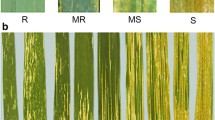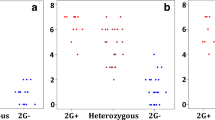Abstract
Synthetic hexaploid wheat (SHW) is known to be an excellent vehicle for transferring large genetic variations especially the many useful traits present in the D genome of Aegilops tauschii Coss. (2n = 2x = 14, DD) for improvement of cultivated wheat (Triticum aestivum L., 2n = 6x = 42, AABBDD). The objectives of the present study were to (1) evaluate genetic diversity among 32 selected SHW accessions with resistance to several fungal diseases using Amplified Fragment Length Polymorphism (AFLP) and Simple Sequence Repeat (SSR) markers and (2) identify diverse SHWs for pyramiding genes conferring resistance to different diseases. These SHWs containing different accessional sources of the D genome were identified from about 1000 SHW accessions developed by the Wheat Wide Crosses program at the International Maize and Wheat Improvement Center, Mexico. Of the 32 SHW accessions eight had resistance to Fusarium head blight (Fusarium graminearum Schw.), seven were resistant to leaf rust (Puccinia triticina Eriks.), eight resistant to Helminthosporium spot blotch [Cochliobolus sativus (Ito et Kurib.) Drechsler ex Dastur (syn.: Bipolaris sorokiniana (Sacc.) Shoem., Helminthosporium sativum Pammel, King et Bakke)], seven resistant to Septoria tritici blotch (Septoria tritici Roberge in Desmaz.), while two were resistant to both Fusarium head blight and leaf rust. Seventeen EcoRI/MseI AFLP primer combinations and 27 highly polymorphic SSR markers including 20 D genome specific markers were screened over all 32 SHW accessions. Among the 703 AFLP fragments scored, 225 were polymorphic across the 32 SHW accessions. Polymorphic information content (PIC) among the SHWs for AFLP ranged from 0.06 to 0.50 with an average PIC of 0.24. Major allelic frequency from SSR analysis ranged from 0.23 to 0.81 with an average of 0.45. Number of alleles per locus for the SSR markers ranged from 3 to 15 with an average allele number of 7.4. Average gene diversity and PIC for the SSR markers was 0.69 and 0.66, respectively, with the highest values being for the D genome specific markers. Cluster analysis showed distinct groups among the SHW accessions studied. Mantel statistics between the distance matrices from AFLP and SSR analyses showed a moderate but significant correlation (r = 0.52**). Our results indicate that the SHW accessions studied possess substantial genetic diversity and are valuable user-friendly pre-breeding materials for breeding improvement of wheat with resistance to Fusarium head blight, leaf rust, Helminthosporium spot blotch, and Septoria tritici blotch. The most diverse SHW accessions can be used for pyramiding resistance genes for different diseases.




Similar content being viewed by others
References
Ali A, Arshad M, Naqvi SMS, Rasheed A, Sher H, Kazi AG, Mujeeb-Kazi A (2015) Comparative assessment of synthetic-derived and conventional bread wheat lines under osmotic stress and implications for molecular analysis. Plant Mol Biol Rep. doi:10.1007/s11105.015-0884-8
Anderson JA, Churchill GA, Autrique JE, Tanksley SD, Sorrells ME (1993) Optimising parental selection for genetic linkage maps. Genome 36:181–186
Autrique E, Nachit MM, Monneveux P, Tanksley SD, Sorrells ME (1996) Genetic diversity in durum wheat based on RFLPs, morphophysiological traits, and coefficient of parentage. Crop Sci 36:735–742
Bai G-H, Ayele M, Tefera H, Nguyen H (1999) Amplified fragment length polymorphism analysis of tef [Eragrostis tef (Zucc.) Trotter]. Crop Sci 39:819–824
Barrett BA, Kidwell KK (1998) AFLP-based genetic diversity assessment among wheat cultivars from the Pacific Northwest. Crop Sci 38:1261–1271
Cooper JK, Ibrahim AMH, Rudd J, Hays D, Malla S, Baker J (2013) Increasing hard winter wheat yield potential via synthetic wheat: II. Heritability and combining ability of yield and its components. Crop Sci 53:67–73
Cox TS (1998) Deepening the wheat gene pool. J Crop Prod 1:1–25
Cox TS, Kiang YT, Gorman MB, Rodgers DM (1985) Relationship between coefficient of parentage and genetic similarity indices in soybean. Crop Sci 25:529–532
Das MK, Bai G-H, Mujeeb-Kazi A (2007) Genetic diversity in conventional and synthetic wheats with drought and salinity tolerance based on AFLP. Can J Plant Sci 87:691–702
del Blanco IA, Rajaram S, Kronstad WE (2001) Agronomic potential of synthetic hexaploid derived populations. Crop Sci 41:670–676
Jaccard P (1908) Nouvelles rescherches sur la distribution florale. Bull Soc Vaud Sci Nat 44:223–270
Lage J, Warburton ML, Crossa J, Skovmand B, Anderson SB (2003) Assessment of genetic diversity in synthetic hexaploid wheats and their Triticum dicoccum and Aegilops tauschii parents using AFLP and agronomic traits. Euphytica 134:305–317
Lage J, Skovmand B, Anderson SB (2004) Field evaluation of emmer wheat derived synthetic hexaploid wheats for resistance to Russian wheat aphid (Homoptera: Aphididae). J Econ Entomol 97:1065–1070
Lelley T, Stachel M, Grausgruber H, Vollman J (2000) Analysis of relationships between Aegilops tauschii and the D genome of wheat utilizing microsatellites. Genome 43:661–668
Li J, Wan HS, Yang WY (2014) Synthetic hexaploid wheat enhances variation and adaptive evolution of bread wheat in breeding processes. J Syst Evol 52(6):735–742
Liu K, Muse SV (2005) PowerMarker: an integrated analysis environment for genetic marker analysis. Bioinformatics 21:2128–2129
Mantel N (1967) The detection of disease clustering and a generalized regression approach. Cancer Res 27:209–220
Martin JM, Blake TK, Hockett EA (1991) Diversity among North American spring barley cultivars based on coefficient of parentage. Crop Sci 31:1131–1137
Mujeeb-Kazi A, Asiedu R (1990) Wide hybridization potential of alien genetic transfers for Triticum aestivum improvement. In: Bajaj YPS (ed) Biotechnology in agriculture and forestry, vol 13, Wheat, Springer Verlag, Berlin, pp 111–127
Mujeeb-Kazi A, Rajaram S (2002) Transferring alien genes from related species and genera for wheat improvement. In: Curtis BC, Rajaram S, Gomez Macpherson H (eds) Bread wheat: improvement and production. FAO, Rome, pp 199–215
Mujeeb-Kazi A, Rosas V, Roldán S (1996) Conservation of the genetic variation of Triticum tauschii (Coss.) Schmalh. (Aegilops squarrosa auct. non L.) in synthetic hexaploid wheats (T. turgidum L. s. lat. × T. tauschii; 2n = 6x = 42, AABBDD) and its potential utilization for wheat improvement. Genet Resour Crop Evol 43:129–134
Mujeeb-Kazi A, Gilchrist LI, Villareal RL, Delagado R (2000) Registration of 10 wheat germplasm lines resistant to Septoria tritici leaf blotch. Crop Sci 40:590–591
Mujeeb-Kazi A, Cano S, Rosas V, Cortes A, Delgado R (2001a) Registration of five synthetic hexaploid wheat and seven bread wheat germplasm lines resistant to wheat spot blotch. Crop Sci 41:1653–1654
Mujeeb-Kazi A, Cortes A, Rosas V, Cano J, Sanchez J, Juarez L, Delgado R (2001b) Genetic diversity for improving scab resistance in wheat. In: Proceedings of Warren Kronstad symposium CIMMYT, Mexico, pp 126–129
Mujeeb-Kazi A, Fuentes-Davila G, Villareal RL, Cortes A, Rosas V, Delgado R (2001c) Registration of 10 synthetic hexaploid wheat and six bread wheat germplasms resistant to karnal bunt. Crop Sci 41:1652–1653
Mujeeb-Kazi A, Gul A, Farooq M, Rizwan S, Ahmad I (2008) Rebirth of synthetic hexaploids with global implications for wheat improvement. Aust J Agric Res 59:391–398
Mujeeb-Kazi A, Kazi AG, Dundas I, Rasheed A, Ogbonnaya F, Chen P, Kishi M, Bonnett D, Wang R-C, Xu S, Bux H, Mahmood T, Farrakh S (2013) Genetic diversity for wheat improvement as a conduit for food security. Adv Agron 122:179–259
Ogbonnaya FC, Abdalla O, Mujeeb-Kazi A, Kazi AG, Xu SX, Gosman N, Lagudah ES, Bonnett D, Sorrells ME, Tsujimoto H (2013) Synthetic hexaploids: harnessing species of the primary gene pool for wheat improvement. J Plant Breed Rev 37:35–122
Pejic I, Ajmone-Marson P, Morgante M, Kozumplick V, Castiglioni P, Taramino G, Motto M (1998) Comparative analysis of genetic similarity among maize inbred lines detected by RFLPs, RAPDs, SSRs and AFLPs. Theor Appl Genet 97:1248–1255
Rajaram S, van Ginkel M (2001) Mexico, 50 years of international wheat breeding. In: Bonjean AP, Angus WJ (eds) The world wheat book: a history of wheat breeding. Lavoisier Publishing, Paris, pp 579–608
Rasheed A, Xia XC, Ogbonnaya FC, Mahmood T, Zhang Z, Mujeeb-Kazi A, He Z (2014) Genome wide association for grain morphology in synthetic hexaploid wheats using digital imaging analysis. BMC Plant Biol. doi:10.1186/1471-2229-14-128
Rohlf FJ (2000) NTSYS-pc. Numerical taxonomy and multivariate analysis system. ver. 2.1, Exeter software, Setauket, New York
Saghai-Maroof MA, Soliman KM, Jorgensen RA, Allard RW (1984) Ribosomal DNA spacer-length polymorphisms in barley: mendelian inheritance, chromosomal location, and population dynamics. Proc Natl Acad Sci USA 81:8014–8018
Sharma P, Sindhu S, Saini M, Verma A, Tyagi BS, Sharma I (2014) Assessing genetic variation for heat tolerance in synthetic wheat lines using phenotypic data and molecular markers. Aust J Crop Sci 8(4):515–522
Sneath PHA, Sokal RR (1973) Numerical taxonomy: the principles and practice of numerical classification. W H Freeman, San Francisco
Soleimani VD, Baum BR, Johnson DA (2002) AFLP and pedigree-based genetic diversity estimates in modern cultivars of durum wheat [Triticum turgidum L. subsp. durum (Desf.) Husn.]. Theor Appl Genet 104:350–357
Strelchenko P, Street K, Mitrofanova O, Mackay M, Balfourier F (2004) Genetic diversity among hexaploid wheat landraces with different geographical origins revealed by microsatellites: comparison with AFLP and RAPD data. In: Proceedings of the 4th international crop sci congress, Brisbane, Australia
Trethowan R, Mujeeb-Kazi A (2008) The use of novel germplasm resources to improve the environmental stress tolerance of hexaploid wheat. Crop Sci 48:1255–1265
Villareal RL, Mujeeb-Kazi A, Del Toro E, Crossa J, Rajaram S (1994) Agronomic variability in selected Triticum turgidum x T. tauschii synthetic hexaploid wheat. J Agron Crop Sci 173:307–317
Warburton ML, Crossa J, Franco J, Kazi M, Trethowan R, Rajaram S, Pfeiffer W, Zhang P, Dreisigacker S, van Ginkel M (2006) Bringing wild relatives back into the family: recovering genetic diversity in CIMMYT improved wheat germplasm. Euphytica 149(3):289–301
Xu SS, Friesen TL, Mujeeb-Kazi A (2004) Seedling resistance to tan spot and Stagonospora nodorum blotch in synthetic hexaploid wheat. Crop Sci 44:2238–2245
Yang W, Liu D, Li J, Zhang L, Wei H, Hu X, Zheng Y, He Z, Zou Y (2009) Synthetic hexaploid wheat and its utilization for wheat genetic improvement in China. J Genet Genom 36:539–546
Zhang PS, Dreisigacker AE, Melchinger M, van Ginkel M, Hoisington D, Warburton ML (2005) Quantifying novel sequence variation in CIMMYT synthetic hexaploid wheats and their backcross-derived lines using SSR markers. Mol Breed 12:1–10
Author information
Authors and Affiliations
Corresponding author
Ethics declarations
Conflict of interest
The authors do not have any conflicts of interest. Mention of trade names or commercial products in this article is solely for the purpose of providing specific information and does not imply recommendation or endorsement by the US Department of Agriculture.
Rights and permissions
About this article
Cite this article
Das, M.K., Bai, G., Mujeeb-Kazi, A. et al. Genetic diversity among synthetic hexaploid wheat accessions (Triticum aestivum) with resistance to several fungal diseases. Genet Resour Crop Evol 63, 1285–1296 (2016). https://doi.org/10.1007/s10722-015-0312-9
Received:
Accepted:
Published:
Issue Date:
DOI: https://doi.org/10.1007/s10722-015-0312-9




